On this page:
Geography
| History
| Politics
| People & Culture
| Climate
| Arts
| Religion
| Economy
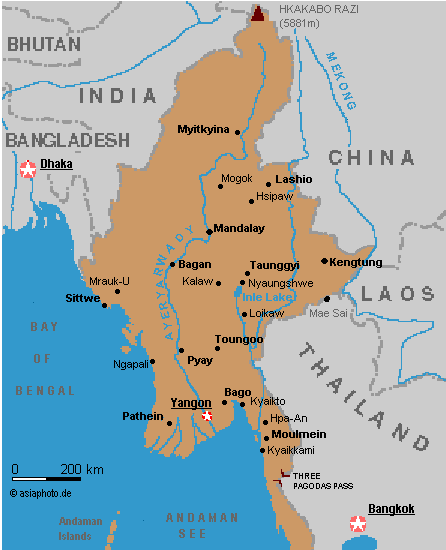 |
GEOGRAPHY
Myanmar is one of the largest countries in South East Asia, stretching over 2,000 km from North to South. It is twice the size of Vietnam, over a quarter larger than Thailand, and Myanmar is bigger than England and France combined.
Myanmar's coastline defines the eastern shore of the Bay of Bengal, running from the Bangladesh border in the northwest down to the Malay Peninsula and Thai territory in the southeast. Southern Myanmar consists largely of the western slopes of the Bilauktaung Range, which constitutes the northern base of the Malay Peninsula. Northern Myanmar, which comprises the great bulk of the country's area, consists largely of the broad river valley of the Irrawaddy. Originating high up in the very eastern extremity of the Himalayas, the Irrawaddy rushes down through great mountain gorges in northern Myanmar before spreading out into one of the largest river deltas in Asia.
|
HISTORY
Sometime in the first few centuries before Christ, a people called the Mons wound their way out of central Asia and down to the Thanlwin and Sittoung rivers. They spoke a dialect of the Mon-Khmer family of languages, and they were the first people known to inhabit what is now Myanmar. The Mons called the region the land of gold, practiced Buddhism, and traded with India's great king Ashoka. The Mons were not to be the only people in Mynamar for long. A few centuries later, the Pyu people arrived from Tibet, and they were followed by the Bamars who settled along the rich Irrawaddy river, which they controlled from Pagan. It was the Bamars who established the First Burmese Empire. Under King Anawrata, they conquered the Mon capital of Thaton and took a legendary 30,000 prisoners back to Pagan. The subtle appeal of the Buddhism the Mon practiced became a powerful conduit of their culture (a pattern seen in India as well) and Anawrata himself converted to Buddhism. The Bamars even adopted the Mon language. The Mons were not, apparently, very much appeased by these signs of cultural appreciation, as they later rebelled and killed Anawrata's son. They were quickly crushed by Kyanzitta, a Bamar general who soon assumed rulership. Kyanzitta's rise marked the beginning of Burma's golden age, when the bounty of rice irrigated by the Irrawady nourished civilization as it never had before. Thousands of temples were built, and the arts flourished. The kingdom's health didn't last long, however. Within a century, Kublai Khan appeared on the horizon, at the head of Mongol armies that were in their time the most powerful military forces on earth. The Khan's demand for tribute was met with defiance by the Burmese King Narathihapate, and the Mongol invasion started to roll in. Ironically, it was not the ferocious Mongols who posed the greatest threat to Narathihapate: he was poisoned by his son, who later lost the kingdom to the Mongols in 1287 at the battle of Vochan. The Mons and the Bamar withdrew to the South, where they founded the enchanting city of Bago. In the North, descendants of the Tai people, called the Shan, founded a kingdom at Innwa. Soon the Mons and the Shan went to war, at almost exactly the time the Europeans started moving into Asia.
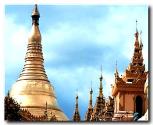
|
It was Nicoto di Conti, a Venetian, who was the first European to encounter Myanmar. Di Conti visited Bago in 1435 and stayed for four months. In 1498, the Portugeuse Vasco de Gama found a sea route to India, opening wide the path to Asia. Soon the Portugeuse had a colony in India at Goa, which they used as a base for eastern trade. De Gama's countryman Anthony Correa made the first trade agreement in Myanmar with the viceroy of Martaban in 1519. The viceroy's king, Tabinshweti, disapproved of the agreement, which was settled without his consent. Tabinshweti attacked Martaban in 1541, and, surprisingly, 700 Portuguese fought on his side. The Loyalist Portuguese retreated to Rahkine, another of the region's kingdoms, and allied themselves with the monarch of Myohuang. In 1600, a Portuguese cabin-boy named Philip de Brito y Nicote came to Myanmar, beginning one of the most legendary tales in Burma's history. De Brito took a job with the king of Rahkine, who had by that time conquered Bago, and soon started constructing forts in the city. De Brito then took a trip to Goa, married the viceroy's daughter, and returned to Bago with men and weapons. As a wedding present to himself, he conquered Myanmar, declared himself king, and set about destroying Buddhist temples. De Brito ruled for 13 years, until the locals finally laid siege to his fortress. After 34 days the bastion fell, and the foreign tyrant was coolly impaled on a wooden stake, his grueling execution lasting three days. Despite the fall of De Brito's personal kingdom, the European presence in Myanmar was there to stay, especially that of the British. Along the with French and Dutch, the British had colonies in Myanmar by the mid-17th century, although a Bamar king named Alaungpaya kicked out both the French and the British later in the century. Alaungpaya conquered Rahkine, extending his border all the way to the Bengal border, until the British Raj in nearby India decided that he had come too close for their comfort. The British invaded Burma in 1819, conquering Rahkine, Tanintharyi, Assam, and Manipur. In 1852, they extended their control to Lower Burma. By 1886, they had annexed the entire country as a province of India and ruled it through the Raj. As Asian independence movements began to cause problems for the British empire around the turn of the century, the British decided that it might be wise to grant some degree of autonomy in Burma. The symbolic gesture was unsurprisingly insufficient, and in 1930 a Burman named Saya San led a major armed rebellion against the British. The revolt was quashed and San executed, but the experience did inspire Britain to make Burma a separate colony. This slight rise in status was not enough, however, for Thakin Aung San, a student leader who spoke out eloquently for independence. San was eventually arrested for his statements, but he escaped to China, where he collaborated with the Japanese. The Japanese made him promises of independence, provided he help them oust the British. In 1941, the Japanese and San did exactly that. In a legendary retreat, the British lost thousands of men, vowing to return. The allies were eventually able to take Burma back, but only after four years of incredibly arduous and deadly fighting. Aung San, who realized that the Japanese had their own imperialistic interests in his country, eventually sided with the allies.
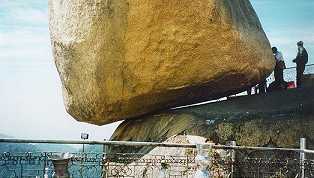 |
The British granted independence to Burma in 1947, though they were worried that local fighting would erupt soon afterward. Aung San, who was ostensibly to have been the new leader, was assassinated the same year, and his colleague Thankin Nu became president. Thankin Nu stayed in power only briefly, asking General Ne Win to assume control as soon as the first signs of civil unrest erupted in 1958. Nu returned to power in 1960, partly because he promised the Mon and Rakhine semi-autonomy. Nu's refusal to grant the same status to the Shan and the Kayins prompted another rebellion in 1962, and this time General Ne Win assumed control without waiting to be asked. Ne Win, a radical communist, had Nu arrested and isolated the country, at the same time declaring the tatmadaw, or military government. After Nu was released in 1966, he fled the country and began to organize a rebellion. His forces managed to hold some land in 1971, but they were eventually thrown out. In 1981, Ne Win stepped down, granting amnesty to all political enemies. Nu returned home and died peacefully. In 1988, a huge demonstration led by students resulted in a violent crackdown by the tatmadaw, who agreed to democratic elections in 1989. When the National League for Democracy (NLD) won 60 percent of the votes, however, the tatmadaw declared the elections invalid, as no agreement had been reached on the role of the new leaders. Since that time the military government has made repeated gestures toward democratic government, although they have in fact taken no real steps in that direction. The democracy movement's current leader, Aung San Suu Kyi (the daughter of Aung San), was awarded the Nobel Peace Prize in 1991 while under house arrest. Suu Kyi continues to lead the movement today.
POLITICAL SITUATION
The Military Government of this poor, mountainous country has been internationally criticized for its brutal suppression of the pro-democracy movement. Dissident leader Aung San Suu Kyi, who won a Nobel Peace Prize in 1991, spent more than six years under house arrest for her peaceful protests. The military has ruled Burma since 1962 and the current regime, run by the State Peace and Development Council (SPDC, former SLORC), came to power in 1988 by suppressing an uprising against military rule that left thousands dead. The military regime has also had to fend off rebellion by nine mostly ethnic guerrilla groups. The government changed the name of the country to Myanmar in 1989 to acknowledge the country's non-Burmese ethnic groups.
|
People I met during my trip were very friendly and some talked about the political situation quite openly. Many were concerned about the still closed universities. However, most people seemed relativly content given the strict regime and the climate of intimidation and fear that no doubt exists, when people can be arrested and tortured at any time.
From the Amnesty International Report 2000: "The military continued to seize ethnic minority civilians for forced labour on infrastructure projects and for portering duties in the Shan, Kayin and Kayah States. Children from eight to 15 years were forced on a regular basis to work on a temple construction in Kunhing, Shan State, in January and February. Civilians were taken by the military for portering duties, carrying heavy loads for long periods, and were beaten if they could not keep up with the column. Forced labour was also reported in areas where cease-fires held, including the Mon and Kachin States, where teenaged children often worked on roads."
See Asiaphoto Linkpage for more information.
PEOPLE & CULTURE
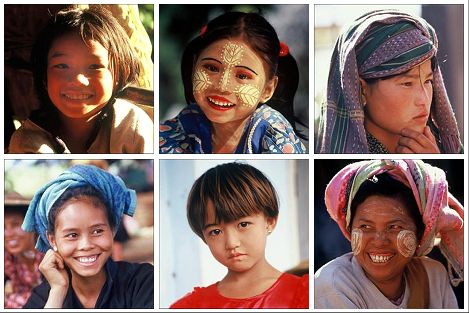 |
Ethnically diverse, Myanmar is a nation of many races - some 130 ethnic groups make up its population of nearly 45 million. The majority of Myanmar's people are Bamars (from which the British coined the name Burma), but the Shan, Kachin, Kayin, Mon, Rakhine and others are also prominent throughout the country. The vast majority of Myanmar's people live in the lowland regions of this river valley, in the Irrawaddy basin. This fertile expanse, which sits within the tropical monsoon belt, is one of the world's great rice-growing regions. Myanmar's population includes dozens of different racial and ethnic groups, including the Mon, Burmans, Kachins, Chins, Shans, Rakhine, and Karens, each of which have historically dominated a particular area of the country. Although Burmese is the major and official language, more than a hundred local and regional dialects are spoken throughout Myanmar. Myanmar's ethnically diverse population is a result of three major migrations from Tibet and Central Asia, the cradle of humanity. The people of Myanmar are descendants of three main branches: The Mon-Khmer, the Tibeto-Burman, and the Thai-Chinese. The Kaya, Mon, Wa, La, Palaung, Pale, Yao, Riang, Padaung, Ylnbaw, Zayein, and others originated from the Mon-Khmer group, while the Shan, Kayin and Taungthu, etc., find their roots in the Thai-Chinese community. The Bamar, Chin, Kachin, Lolo, Rahkine, Kadu, Hpon, Maru, Lashi, Rawang, Azi, Nung, Daru, Yaw, Mro, Inthat, Naga, Gauri, Lisu, Lahu, among others, evolved from the Tibeto-Burman group. Kuthodaw Pagoda, in Mandalay, which houses the entire Buddhist scriptures carved onto 729 marble slabs is "The world's largest book". Built by King Mindon, it is indeed a rare and splendid sight. Myanmar's unique historical and cultural heritage dates back over 5,000 years. Evidence confirming the existence of stone age people has been found throughout the country. Early Myanmars were said to be Mons, and the first politically important inhabitants were the Pyu who date back to the early period of the Christian era. It was Bagan, however, which was founded in the 11th century, that gave rise to the dominant culture and civilization in Myanmar's history.

|
Myanmar has a population of about 48 million. It consists of some 130 ethnic groups, with their own languages and dialects. The term Myanmar embraces all national groups the Barmar, the Chin, the Kachin, the Kayah, the Kayin, the Mon, the Rakhine and the Shan. The Bamars make up 69 percent of the total population. Myanmar lies on the cross-road of two of the world’s great civilization--China and India, but its culture is neither that of India nor China exclusively, but a blend of both interspersed with Myanmar native traits and characteristics. Buddhism has great influence on daily life of the Myanmars. The people have preserved the traditions of close family ties, respect for the elders, and reverence for Buddhism. Myanmars are contented and cheerful even in the face of adversities and known for their simple hospitality and friendliness. Ethnic groups: Burman 68%, Shan 9%, Karen 7%, Rakhine 4%, Chinese 3%, Mon 2%, Indian 2%, other 5%
| Growth rate: | 1.84% (1996) |
| Birth rate: | 30.01 births/1,000 (1996) |
| Death rate: | 11.66 deaths/1,000 (1996) |
| Fertility rate: | 3.83 children/woman (1996) |
| Male life expectancy: | 54 (1996) |
| Female life expectancy: | 57 (1996) |
| Infant mortality rate: | 80.7 deaths/1,000 live births (1996) |
National Holidays & Festivals
| JAN 4 | Independence Day |
| FEB 12 | Union Day |
| MAR 2 | Peasant’s Day |
| MAR 12 | Fullmoon Day of Tabaung |
| MAR 27 | Armed Forces Day |
| APR 13-17 | Thingyan Festival (Water Festival) and Myanmar New year Day |
| MAY 1 | May Day (Workers’ Day) |
| MAY 10 | Fullmoon Day of Kason |
| JUL 8 | Beginning of Buddhist Lent |
| JUL 19 | Martyrs’ Day |
| OCT 5 | End of Buddhist Lent (Thadingyut Festival of Lights) |
| NOV 3 | Tazaungdaing Festival of Lights |
| NOV 13 | National Day |
| DEC 18 | Kayin New Year Day |
| DEC 25 | Christmas Day |
CLIMATE
Myanmar's climate is tropical: during the cool season from late November through February, temperatures are pleasantly mild ranging from 21C to 28 C; the hot season from March to April can see the mercury reach as high as 45 C; and during the months of the rainy season, from May to October short rainstorms are frequent in the late afternoons.
The best time to visit Myanmar is from October to mid-May.
ARTS
|
Myanmar is an enchanting country with a rich history in arts and crafts. Mandalay, the ancient capital and the glory of Myanmar Kings, represents the largest repository of Myanmar arts and crafts.
Visitors can observe carvers of ivory, wood and stone, in addition to makers of gold leaf, silk weavers, silversmiths and bronze-casters, as they ply their respective trades according to the time-honored traditions of their forefathers.
The pagodas, religious monuments, and major Buddhist sculptures seen all over Myanmar are authentic examples of the rich tradition of Bagan arts andcrafts and of prior eras of craftmanship so evident throughout Myanmar's history.
RELIGION
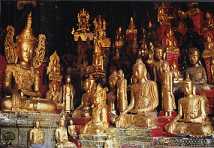 |
The first imperial capital of Myanmar, Bagan, was by the beginning of the 11th century A.D, a world centre of the Theravada Buddhism. Successive kings and their subjects choose to glorify their faith through the lavish and ambitious construction of monuments and Buddhist culture. Therevada Buddhism is the predominant religion with over 80 percent of the people embracing it. There are also Christians, Muslims, Hindus and some animists.
Major Religions
Buddhist 89%, Christian 4% (Baptist 3%, Roman Catholic 1%), Muslim 4%, animist beliefs 1%, other 2%
ECONOMY
Myanmar is incredibly rich in natural resources. The imperial jade, the best pigeon blood rubies and the finest sapphires, all come from this soil of Myanmar. The fame of Myanmar Gems, Jade and Pearls has attracted many of the wealthiest jewel dealers in Asia and the world.
 |
Myanmar teak is Asia and the world’s wonder, especially the sight of thousand of elephants and riders who each year extract more than a million tons of teak and other hardwoods from Myanmar’s deciduous monsoon forest, showing off Myanmar’s thriving elephant culture and its economic importance. Since late 1988 Myanmar has replaced the centrally planned economy to a more liberalized economic policy based on market-oriented economic system. In moving towards a more market-oriented economy, Myanmar has liberalized domestic and external trade promoting the role of private sector and opening up to foreign investment. Foreign Investment Law, New Central Bank of Myanmar Law, Financial Institutions of Myanmar law and Myanmar Tourism Law have been enacted and Chambers of Commerce have been reactivated. Myanmar is richly endowed with renewable and non-renewable energy resources which are being exploited by the state sector with the participation of local and foreign investors. Agriculture remains the main sector of the economy and measures have been taken to increase productivity, diversification of crop patterns, and revitalization of agriculture exports. Labor force: 16.0 million (1992) Unemployment rate: N/A Inflation Rate: 38% (1994) Gross domestic product (total value of goods and services produced annually): $41.4 billion (1994 est.) Budget: $10.0 billion (1995 est.) Debt: $5.5 billion (1996) Exports : $879.0 million (1996 est.), primarily pulses and beans, teak, rice, hardwood Imports: $1.5 billion (1996 est.), primarily machinery, transport equipment, construction materials, food products, consumer goods Defense spending: N/A Highways: 27,000 km (1995) Source: 1998 CIA World Factbook
* * * * * * * * * * * * * * * * * * * * * * * * * * * * * * * * * * * * * * * * * * * *
The shameful situation in Burma
November 1, 2007, usenet article from "labor"
After Ne Win was ousted by popular uprise in 1988 General Saw Maung seized power in a coup. In May 1990 election NLD won by 83% but the military junta refused to hand over power and on the contrary pursued the democratic victors. Early in his administration Gen Saw Maung became psychologically unstable and was ousted by strongman General Than Shwe who promoted himself to Ultra Supreme Commander Senior General and increased the strength of the arm forces to over 400,000 soldiers with several thousand of them made up of under age child soldiers against the objection of the UN and world community. The junta was too proud, it had the guns and refused to change course despite the plea from its own people and the elders/seniors/statesmen of Burma. Consequently the notorious junta fell out of favour with ASEAN. Sanctions were imposed by the US and the EU. The regime became very unpopular with the masses and its ethnic minorities. But the junta formulated law to cover and protect themselves, surrounded themselves with informers and "Yes-men" and pushed ahead with intimidation, torture, jailing and murder of men, women, students, monks, oppositions and its citizens who would not agree with them and support them or fall in line with their rule and unfair governance similar to the way Nazi Germany went about its business.
It is widely reported that SLORC/SPDC soldiers were overlooked when they raped the ethnic women and their daughters. None of the soldiers were investigated and charged. There were forced labour, forced relocation, confiscation of live stock for the army, capturing villagers from the villages and forcing them to work as porters and janitors without wages and food, using these unfortunate people against their will as human mine sweepers and discarding their bodies along the road side when they are of no use to the army. The soldiers burnt down bamboo housed some times with old disable men/women in the house unable to move. They Bullied farmers to sell their produce at an unreasonable low price to the army, etc.. All these had a detrimental effect on the morale and social fabric of the people who gradually became very bitter, distorted with despair and losing confidence in themselves and those around them. But this junta continued regardlessly to tell the people that they are matching forward hand in hand with the people. That the junta is of the people, for the people and by the people and handing down unreasonable very lengthy (21, 24, 50, 75 years) jail sentences to those who oppose them and refuse to toe the line. The education system deteriorated with the devaluation of the high school and university education. The State Health System is shameful so much so that Than Shwe himself goes to Singapore for treatment. The fighting with the ethnic minorities continues. The junta plants thousands of land mines killing thousands of innocent people in the villages and they feel quite good going to bed every night with that thought. The junta continues to divide and rule and handing down unjustified sentences on political opponents simply designed to deliberately break them and try to eliminate them to safe guard the generals from their crimes. The junta does not like questions that expose them. The junta would find fault on them and put them away. The junta is acutely aware that the majority of the people are not on their side so they rule by fear and the gun. The junta refuses to discuss the affairs of the nation with the people's representatives because they have no legs to stand and falsely believe only the generals are capable of ruling the country. The general rule by force and intimidation and bulldoze people to accept things the tatmadaw way. The junta does not respect the opinion of the people. The people have no voice and certainly no say in the matter. The generals talk of democracy but essentially they behave as brutal dictators. The TV and media are used for the junta's propaganda. The news papers would show pictures of the generals in great meetings singing their praises. The news papers write nothing good about the democratic opposition. The media and news papers are used to discredit and reduce the democratic parties and to run favourable articles for the pro junta group USDA. University students are forced to join USDA otherwise the students are not allowed to sit for their final exams. Without USDA membership graduates are denied scolarship. The junta uses the USDA as an instrument do dishonest and disgraceful things for the tatmadaw which the tatmadaw does not want to be seen as done the deeds. The tatmadaw directed the USDA to commit massacre at Depeyin and then arrested the democratic parties as being the perpetrators. All junta members who committed murder and crime were all set free. Several NLD members were arrested without trial at the pleasure of the junta. Several NLD offices were closed down and all their documents confiscated and examined by USDA. End of 2006 five 1988 generation students leaders were illegally arrested without trial simply because they pose a threat to the junta. The junta would grant amnesty to thousands of prisoners and releasing only a hand full of opposition members.
It has been widely reported that the Generals have damaged the economy of the country. This is evident in the value of the Kyat. The junta is spending nearly 50% of the overall national expenditure on arms and ammunition to protect the tatmadaw from the people. Most of the trade was with China to secure protection in the Security Council. A very large number of the population is suffering from HIV Aids but this matter ranks very low in the list of priorities. The junta has changed the capital city of the country to Pyinmanar and has changed the flag of the nation with only one star without the permission and consent of the people. The junta's dishonesty is well known as they engage in lying and deceiving the people to achieve their objectives. If the person that planted the bomb is not found they blame it on the opposition. The important matters concerning the nation is disclosed to the overseas media first instead to it own people. The people frequently come to know of these matters via the overseas news. So much for respect for the people.
The regime has also defied repeated calls by the International Labour Organisation to end forced labour not to mention forced relocation, forced confiscation, etc... The generals are the wealthiest people in the country with unexplained wealth. Half of the generals seem to be concerned with the state of the nation and most of the other half is power drunk. The top general's actions and decisions are based on astrologers' predictions instead of scientific findings. What can one expect with their education level? The junta relies heavily on foreign investment and foreign manufacture and thought they would surpass China. The country has suffered from brain drain and most of the intellectuals have left for other countries because of the disastrous policies of the junta. Several foreign investments have pulled out. The Finance and Banking systems and the Science and Technology structure have run down setting the country several years behind the neighbouring states. The country suffers from hyper inflation and poverty is wide spread with some families have only one meal a day. The junta's priority is purchase of arms for the tatmadaw and the protection of the army although it has no obvious enemy. The peoples' welfare rank very low in the list of priorities. It is more important for the generals to protect themselves. So those who are problematic to the tatmadaw' s policies are exterminated even to the extent of engaging in purging with genocide. Citizens are picked up in the early morning to avoid wide spread spectacle and objection of the people around. To achieve this end the junta is engaged in a sham National Convention widely known to be made up of special hand picked pro junta personnel to perpetuate military rule despite the fact that the people have told the nation in the 1990 general election that they do not want military rule. The junta is shaping the constitution to safe guard themselves by filling 25% of the parliament seats with unelected military personnel to act as eyes and ears to protect the power hungry generals. The junta demands that the President of the country can only be a general from the arm forces and that the tatmadaw will have the veto power over the parliament. The constitution gives the junta the right to nab the country at any time after declaring emergency. The generals do not trust any one and believes only the tatmadaw is capable of ruling Burma and is acutely afraid of reprisals. They are now engaged in installing military officers in civilian positions over career civilian officers. The junta is engaging "Sawn Arr Shin" pro junta militia or thugs and freed jailed criminals to beat up and abuse peaceful demonstrators who cannot live a normal life with 500% fuel price rise last month. The junta does not understand the importance of dialogue with the people before such a hefty price rise. This junta does not care about the people. The junta has no consideration for the civilian officers although the civilians are more educated, experienced and qualified than the military officers who are only qualified to pull the trigger. It is an unfair strategy to protect the generals and military rule. They have caught hold of the tiger's tail and are unable to let go of it. Their hands are still wet with blood and the junta calls this Democracy.
* * * * * * * * * * * * * * * * * * * * * * * * * * * * * * * * * * * * * * * * * * * *
More info needed?
Check out the Travel Tips Page. If you like to see more photos like above, visit the sites of the copyright-holders. They are listed on the Linkpage. There you can also find a choice of Asian magazines and newspapers.


